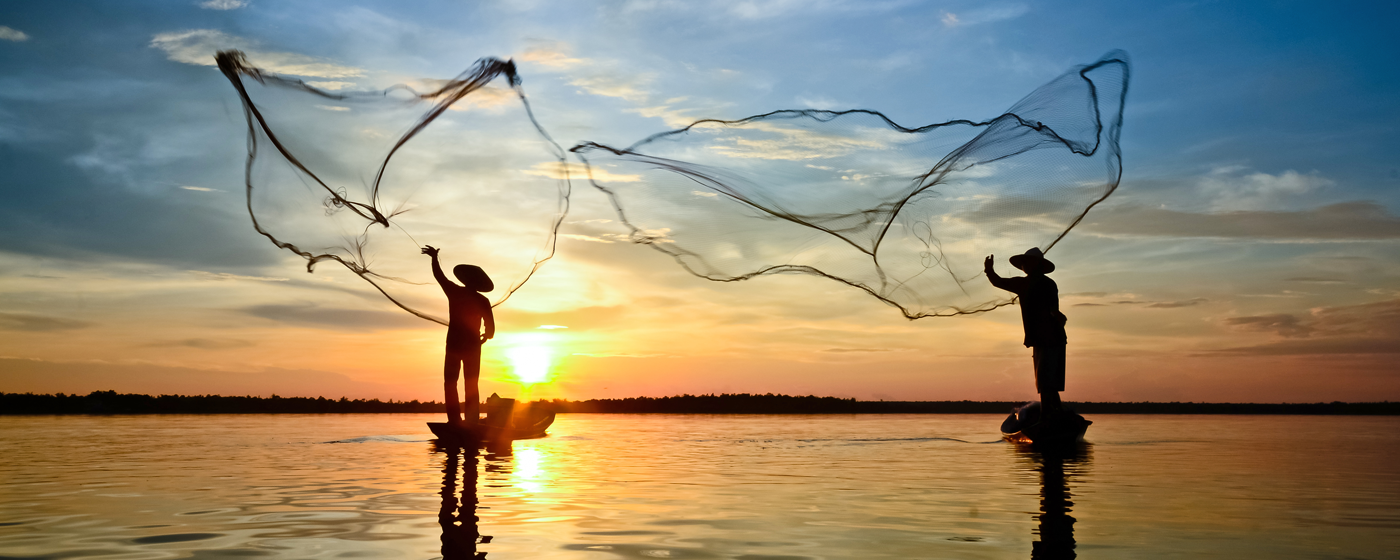Fishing techniques
Fishing techniques vary according to the type of fish to be caught, but have not evolved much over the centuries. Today, traditional methods are used alongside more industrial techniques. Nets, traps and fishing rods are used universally and such equipment has either evolved as technology has progressed or has remained dependent on local resources and knowledge in regions untouched by industrialisation.
Fishing practices
There are many different techniques for traditional and industrial fishing depending on the aquatic species to be caught. Whether for recreational fishing or professional fishing, the basic tools can be used actively by hunting down the fish (‘gun’, seine, trawl net) or passively by waiting for the fish to seek out the device (trap, line, net). A seine can catch a large quantity of fish and even entire shoals offshore, while the size and habitat of other species require them to be fished individually. Although equipment has evolved throughout history, the techniques have often remained the same.
Sardine fishing, for example, has been popular since Antiquity and has evolved very little. Two types of nets are used: gillnets in which the fish are caught by their gills, and seines which encircle the shoal, thereby trapping the fish. The advantage of seines is that they catch the fish alive. The fish are then hauled on board using dip nets, a sort of scoop-shaped landing net. This practice is common in industrialised fishing, which supplies the international market, as well as in traditional fishing which feeds local fishing populations.
Trawling is another type of fishing using nets and entails dragging a funnel-shaped net (trawl net) behind a boat (trawler), thus catching the fish as it passes. The pelagic trawl catches midwater fish such as tuna, mackerel and anchovies, while the bottom trawl targets species which live near the seabed, such as cod, whiting or haddock.
Octopus fishing exploits the natural tendency of this cephalopod to shelter in the hollows of the seabed. Clay pots or small plastic barrels, without a lid, are attached to a rope at regular intervals, then placed in the water. The recipients act as a trap and are collected a few days later. Eel traps use the same principle.
Whether it is fished in Arctic regions or Lake Geneva, the Arctic char is caught using a rod equipped with a line weighted with a lure. In Switzerland, it is caught ‘à la gambe’, using a line with a series of hooks, while in the Far North, Inuit use a polished piece of walrus tusk.
Other fishing methods take advantage of a human-animal alliance, as is the case for hunting on land. In China, for example, trained cormorants are used to fish. The base of the bird’s neck is tied to prevent it from swallowing its prey. These birds are like ‘underwater missiles’ and can catch considerable quantities of fish, enough to provide food and income for an entire village.
Fishing using rods, spears or guns may be an individual practice carried out to provide food or a sport practised in accordance with rules enforced to help protect sea life.
Deep-sea fishing is strictly regulated to avoid overfishing which causes the depletion of stocks and the disappearance of species. The number of days, the type of equipment used (type of boat, size of engine, size of nets or meshing) and the authorised quotas are closely monitored by the authorities. However, these laws are not a long-term solution to the imbalance of aquatic ecosystems. They do not regulate the accidental catching of prohibited fish or fish deemed ‘uninteresting’ from a commercial point of view, called the bycatch. Most of these fish die or are already dead when returned to the sea.
BODIS, Luc, 2015. Manuel pratique de la pêche en mer et en eau douce. Rennes : Éditions Ouest-France.
DESCHAMPS, Gérard, 2005. Les lignes : pêche professionnelle en mer et pêche de loisir. Versailles : Éditions Quae.
DURANTEL, Pascal, 2003. Pêche, l’encyclopédie. Chamalières : Éditions Artémis. ISBN 9782844162281.
Éd. Atlas, 2000. Atlas pratique du pêcheur. Paris : Éditions Atlas Glénat.
HOUDOU, Gérard et DURANTEL, Pascal, 2005. Pêche à pied en bord de mer. Chamalières : Éditions Artémis, ISBN 9782844163684.
LUCHESI, Michel, 2015. Le Petit Larousse de la Pêche en eau douce, Techniques, matériel, poissons. Paris : Éditions Larousse.
MARGOULIES, Michel, 2001. Grande pêche sportive : espadon, thons, marlins. Bruxelles : Éditions du Gerfaut.




